Making Movies Three-Dimensional
by Donald E. Simanek
Roots of 3-d cinema.
We live in a three-dimensional world. Yet in books, magazines, cinema and television, that world is squashed down to two dimensions onto the flat page, or on the flat screen of a darkened theater. Artists and photographers have learned to use perspective, shading, texture and motion to give us clues to depth and solidity, but it still isn't the real thing.Our two eyes, spaced about 65cm (2.5 inches) apart, see the world from two different vantage points. They act as a rangefinder, providing important information about distance and depth. Our brain synthesizes these two views (doing the triangulations) into a perception of a three-dimensional world.
From the earliest days of photography we have known how to photograph depth just as our eyes see it, and even how to present those photos separately to our eyes to recreate fully three-dimensional scenes. But technical problems have long stood in the way of presenting such 3-d pictures to entire audiences. Now most of these have been overcome.
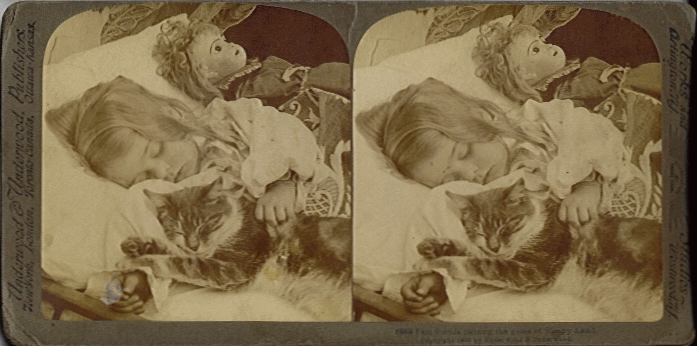 |
| Stereo View Card, 7 by 3.5 inches. Fast friends passing the gates of Sleepy Land. Copyright 1903 by Underwood and Underwood |
|---|
Charles Wheatstone patented a stereoscope in 1838, initially using it to give an appearance of solidity to stereoscopic drawings that he made as early as 1832. Stereo drawings consist of two pictures that show a subject or scene from two slightly different viewpoints, just as the human eyes do.
A few years later photography was invented. From the earliest days of photography, photographers captured three-dimensional scenes using two-lensed cameras. The resulting pair of pictures could be mounted on stiff cards (as in the example above) and viewed with Whetstone’s stereoscope as fully three-dimensional recreations. Mathew Brady's photographers documented the U.S. Civil War and the Westward expansion in stereo photographs, using stereo wet-plate cameras.
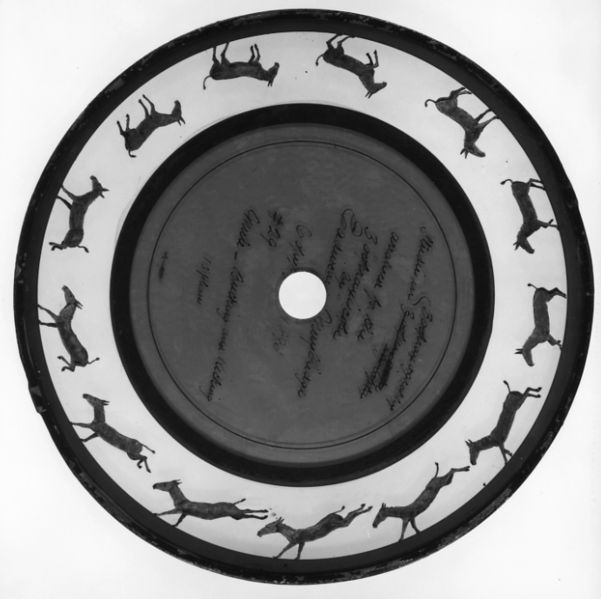 |
| One of Muybridge's zoöpraxiscope disks. Source: Wikipedia. |
|---|
The first moving pictures were children's toys that used spinning wheels with mirrors and slits for viewing animated drawings in rapid succession. These were popular as early as the 1830s. Several methods were devised to make and view animated photographs of real subjects. Eadweard Muybridge, in 1871, used an array of cameras triggered in quick succession to study the motion of humans and animals, and was the first to show that a trotting horse actually has all feet off the ground at once. Muybridge even invented the zoöpraxiscope, a device for projecting such images, affixed to a rotating glass disk, onto a screen. In 1895 Frenchman Louis Lumiere developed a motion picture system (camera, processor and projector) called the Cinematographe.
In 1889 William Friese-Green received a British patent (No. 10131) for a "cronophotographic" camera that recorded up to ten photographs per second on perforated celluloid film. The results were unreliable and unimpressive. In the 1890s he obtained the first patent for a stereo (three-dimensional) movie process and a method to project two movie films onto a screen side by side. Audience members used prismatic stereoscopes to fuse the two images. This was obviously not easily adaptable to large audiences.
So we see that 3-d motion pictures are nothing new, but many technical problems had be solved to implement the idea for theatrical exhibition.
Recording two images on film as they are seen by the human eyes is relativity easy. Two synchronized motion picture cameras side by side, with lens axes aligned parallel, will do that. The left and right eye views must then be presented to each person in the audience so that the right eye pictures are seen only by the right eye, and the left eye pictures only by the left eye. An early method for doing that was the anaglyph—projecting the left and right images through red and green (or red and blue filters) with matching filters in inexpensive cardboard frame glasses worn by viewers. The color separation of the two images was never complete, and the system was plagued with annoying colored "ghost images". The method was also used in books and comic books, and even occasionally on television. This is a system that deserved to die, but it survived because it was inexpensive and easily adaptable to existing theater equipment. When color films became common, some 3-d movie systems still used anaglyph glasses, producing a hybrid image that showed depth as well as color, both rendered badly.
Physical studies of crystals led to a better method. Many natural crystals are anisotropic, having different refractive indices along different axes. Light passing through such a crystal emerges with two components, each having its electric vector in a particular plane. Each of these components is called "plane polarized" light. Edwin Land, in the 1930s, found a way to manufacture relatively inexpensive polarizing sheets of polarizing plastic, called Polaroid ®, which absorbed one component of the light, transmitting only light polarized in one plane. Such polarizing materials soon found many uses, and provided a better way to separate the left and right eye images in 3-d motion pictures.
 |
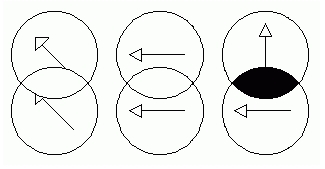 |
| A: Ordinary light sources emit unpolarized light, which may be thought of as emitting light pulses with their electric vectors aligned in many directions without preference. B, C, and D: show polarized light in which all light pulses are aligned along a particular direction. |
Light passes through polarizers with axes aligned, but is blocked by polarizers with axes at 90°. |
|---|
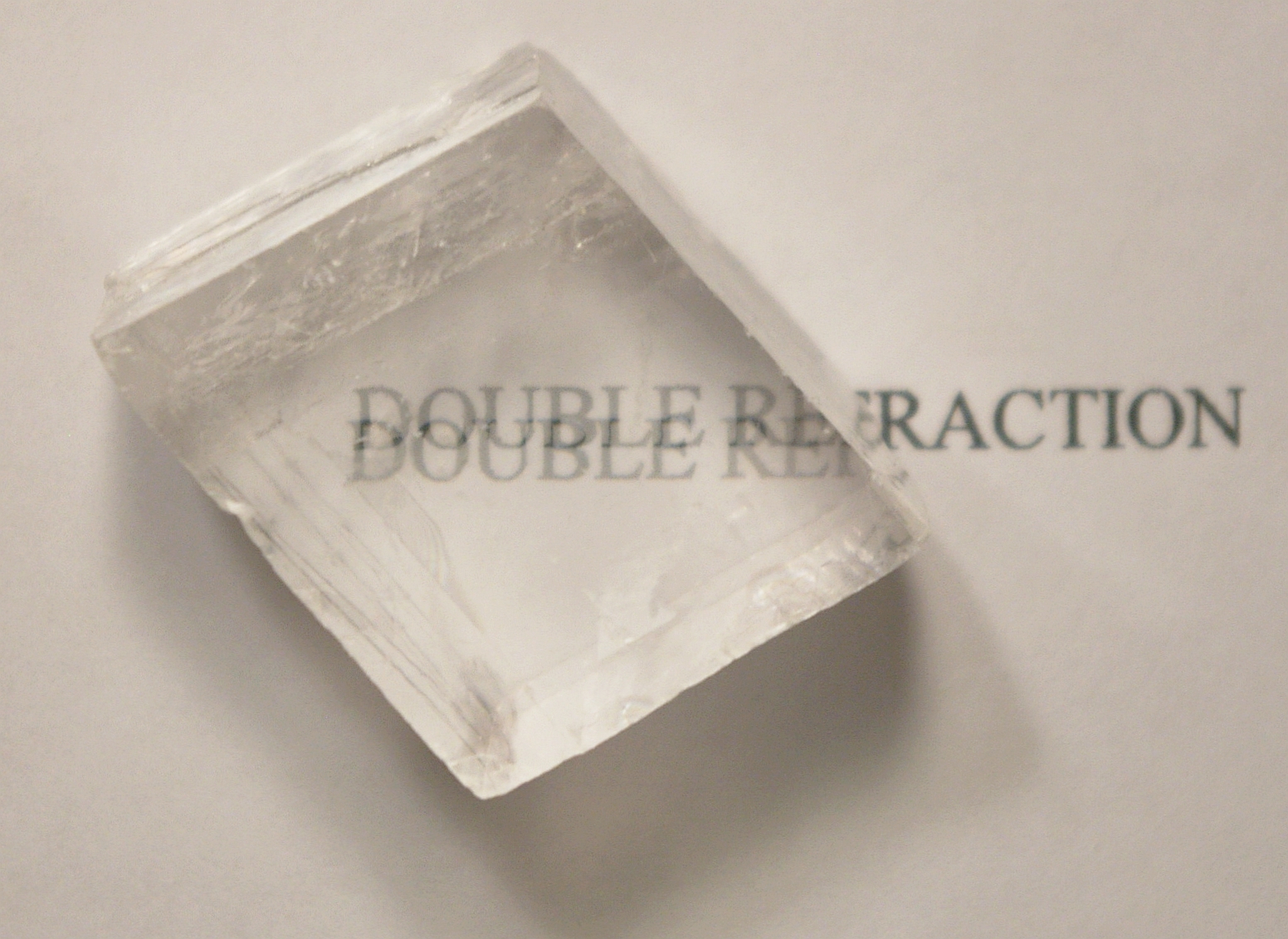 |
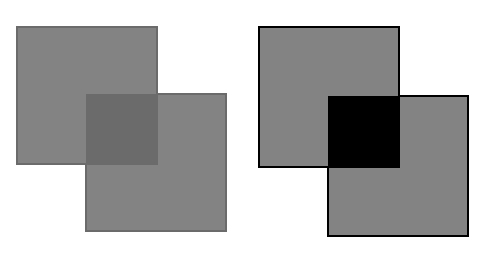 | |
| Calcite, a natural crystal exhibits double refraction. The two images are polarized at right angles to each other. |
Polarizers with parallel axes do not block the light |
Polarizers with crossed axes block the light. |
|---|---|---|
The 3-d boom of the 1950s.
In the early 1950s 3-d movies were seen as Hollywood's answer to the threat of television. The new 3-d projection system used plane-polarizing filters to keep the two images separate. Theaters required a new metallic-surface screen to preserve the polarization direction of the light. Polarizing filters were neutral gray, so they presented no serious problem with color films, and ghost images, though still present (especially when viewers tilted their heads) were less annoying than the colored ghosting of the anaglyph method. The left and right eye views recorded on two separate 35mm films were projected by two mechanically synchronized projectors. Keeping these two images precisely aligned on the screen was a continual problem. If one film was damaged and repaired, the other one had to be cut and shortened by the same amount in the same place. In those days every theater already had two side-by-side projectors, each holding about 10 or 15 minutes worth of film. The projectionist switched from one projector to the other upon seeing a cue signal printed on the film frame, appearing as a bright dot at the upper right corner of the screen. With 3-d, much larger film reels were used, holding nearly an hour's worth of film, with both projectors running simultaneously. An intermission was required in the middle of the movie to allow the projectionist to reload two new reels of film. Then there was the brightness problem. A polarizing sheet transmits just under 50% of the incident light, so the light, after passing through a polarizer at the projector and through a polarizer in front of the eye, reaches the eye with only (0.5)(0.5) = 0.25 as much brightness. In spite of these problems, 3-d remained popular for several years. But in the quest for more realism, wide-screen systems such as Cinemascope attracted greater audiences, and the 3-d boom died. Too bad, for Hollywood had just begun to produce some decent quality films, such as "House of Wax", "Kiss Me Kate" and Hitchcock's "Dial M for Murder". Perhaps one reason 3-d lasted even those few years was that it coincided with a boom in amateur stereo still photography and the availability of quality stereo 35mm still cameras from major manufacturers like Realist, Kodak and Revere.
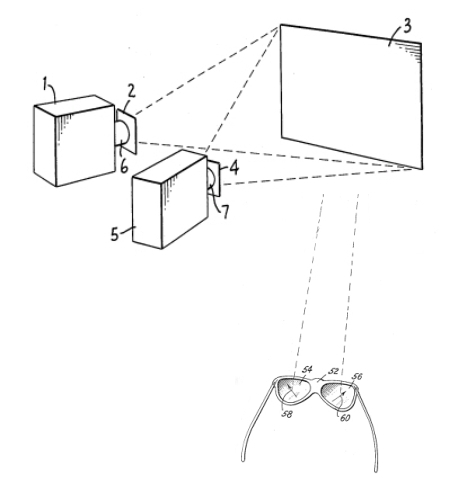 |
The 3-d system using two projectors. Polarizers 2, 4 in front of each projector match the alignment of polarizers 54, 56 of the viewing glasses. |
|---|
In the 1970s several methods were introduced to print left and right eye images onto a single strip of movie film, either side by side, or one above the other. This relieved the projectionist of the nuisance of monitoring image alignment, but the movies filmed this way were not produced with the greatest care, nor was their content of academy-award quality.
Again, 3-d dropped from sight, except for some dedicated 3-d systems at theme parks, trade shows and World's fairs. During this time a better method arose to separate left and right eye images—the replacement of linear polarizing sheets with circularly polarizing materials.
So now, some 50 years after the first boom in 3-d cinema, are we ready for a repeat performance, but with much-improved methods? Several technological innovations may bring this about: (1) the recent rapid introduction of digital projection into theaters, using the Digital Light Processing (DLP) chip, (2) circular polarization, and (3) brighter and more efficient light sources in projectors. These improvements have eliminated most of the annoyances of earlier 3-d systems. Also, we may hope that film producers have learned a valuable lesson and will use the medium with restraint, for an "immersive" experience, rather than for the surprise or shock value of "throwing things at the audience."
IMAX 3-d film presentations have been around for several years, showing on some 750 screens in the USA. Also, there are now 887 theaters in N. America and 105 in Europe equipped to show Real-D digital 3-d movies. Several 3-d digital films already have appeared, and other major productions are in the works, some by first-rank directors. New 3-d movies are reaching theaters at the rate of one per month.
 |
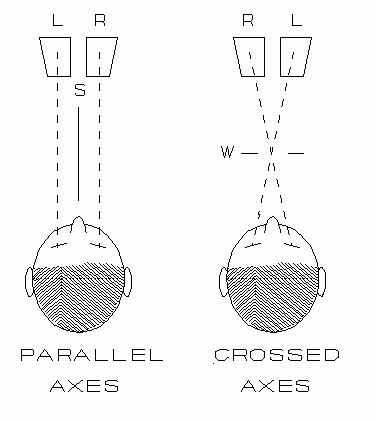 The stereo view card that opens this article may be viewed in 3-d by the parallel axis method, sometimes called the "wall-eyed" method. Relax the eyes to focus on a distant object, so the eyes are aimed for distance. The two pictures will move together and merge, but be out of focus. Then re-focus the eyes on the picture without converging the eyes, and the picture should snap into full 3-d. It takes some practice. Some find that it helps to hold a black paper septum at S, between the pictures, as shown.
The stereo view card that opens this article may be viewed in 3-d by the parallel axis method, sometimes called the "wall-eyed" method. Relax the eyes to focus on a distant object, so the eyes are aimed for distance. The two pictures will move together and merge, but be out of focus. Then re-focus the eyes on the picture without converging the eyes, and the picture should snap into full 3-d. It takes some practice. Some find that it helps to hold a black paper septum at S, between the pictures, as shown. The 3-d picture of a praying mantis is printed for cross-eye viewing in 3-d. This method also requires some practice. The right eye looks at the left picture and the left eye looks at the right picture, fusing them into one, and then pulling them into focus. When you succeed you will see a picture with depth, flanked on either side by the flat versions of it. Some people find it helpful to hold a black paper with a window at position W to block out all but the fused stereo picture. This photo, by Donald Simanek, was taken with a homebuilt camera having two matched lenses spaced 3/4 inches apart. Instructions can be found at http://www.lhup.edu/~dsimanek/3d/illus2.htm. Other examples of cross-eyed stereo presentation may be seen at http://www.lhup.edu/~dsimanek/3d/stereo/3dgallery.htm. Many web sites have stereos presented for various methods of viewing. |
How it works: Two points of view are required.
Source material for 3-d movies can be photographed on conventional film using integrated or dual-camera systems, or newer, more compact, digital cameras. In either case, two images, from two different points of view, are simultaneously photographed.
Some recent 3-d films began with digitally animated source material. Digital animation software constructs scenes within a 3-dimensional mathematical visual space, so the computer code contains the information necessary to extract the two separate points of view needed for a stereo result. Computer methods also allow extracting 3-d information from "flat" 2d films (with manual tweaking) but the result is "fake" 3-d. This can, however be very effective if carefully done, as was the recent conversion of the 1991 film "Nightmare Before Christmas" from 2-d to 3-d. Live-action 3-d films are now being released and more are coming this summer.
Early silent films, especially those shot with hand-cranked cameras, had a variety of frame rates, often 16 frames/sec. These slow rates gave the pictures a "jumpy" or flickering effect. Movies were called "flicks" for good reason. With the introduction of optical sound tracks, requiring a faster film travel rate for decent frequency response, the standard became 24 frames/sec. Projectors flashed each frame on the screen twice in succession to further reduce flicker. This was fast enough so that the eye's persistence of vision blended the pictures into a smooth and continuous motion. Television in the USA standardized on 30 frames/sec (because of the simplicity of synchronization with the 60 Hz power system), each frame being presented twice by the interleaved scan system. Early Cinerama panoramic films were shot at 26 frames/sec, and the short-lived Todd-AO process used 30 frames/sec. IMAX®HD uses a camera and projector rate of 48 frames/sec. But today, except for some limited release large format films, the film standard is still 24 frames/sec with each frame flashed on the screen twice by a dual-blade mechanical shutter. Today's digital projection can handle higher frame rates, and digital motion picture cameras could easily be adapted to higher frame rates as well, so perhaps we'll see this improvement in coming years.
IMAX 3-d. Bigger is better.
Giant-screen IMAX presentations use two synchronized 70mm films running simultaneously through the projector. A rotating shutter flashes the L/R images alternately on the screen, the screen receiving 96 images per second, alternating L/R images. Two methods are available for separating the images and presenting them to the proper eye. The left and right images are polarized at right angles to each other. The audience is supplied with polarizing glasses to separate the images. This is the 1950s 3-d system but with much larger film frames, better syncrhonizaton of the two film strips (running in one projector), much larger (metallic) screen and larger area polarizing glasses. Another method uses an infrared field filling the theater (much like the one used to provide sound service to the hearing impaired), to synchronize electronic liquid-crystal glasses worn by the audience. These glasses rapidly switch the sense of polarization so that each eye is blocked from seeing the picture intended for the other eye. This method does not require a special metallic screen. To my knowledge, 3-d IMAX is only shown in flat-screen theaters. It would be technically infeasible for presentation on the highly curved "dome" screens.
Digital Projection. Pixelating movies.
|
|
Digital movie projection systems use the DLP (Digital Light Processor) chip, a remarkable device from Texas Instruments. Each chip can have up to 2 million tiny aluminum reflective mirror surfaces, about 16 micrometers width, or about 1/6 the width of an average human hair. These can be electrically triggered individually to tilt just a little, enough to reflect a spot of light back into the optical system lenses in one position (ON). In the other position the light does not pass through the optics to the screen (OFF), but is directed to a light absorbing heat sink. These mirrors can toggle at rates as high as several thousand times per second. If they are on most of the time, the mirror produces a bright dot on the screen, but if they are off most of the time, that spot is dark. In between, 1024 shades of gray can be produced by controlling the proportion of time the mirror is ON. Theater systems use three chips, one for each primary color, so more than 35 trillion colors can be produced when the light is recombined onto the screen. That's far more than the eye can distinguish. At present most digital theater systems have "2K" projectors that deliver a picture of 2048 by 1080 pixels, but "4K" projectors are becoming available that double that linear resolution.
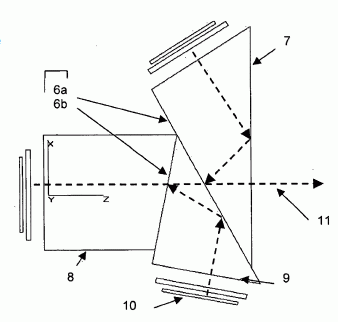 | 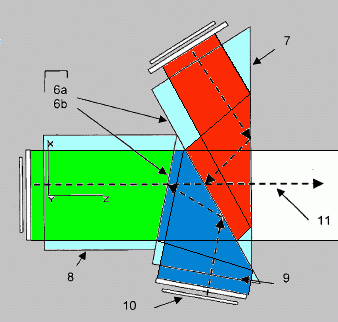 |
| The two dichroic mirrors can be incorporated
into a beam splitting prism, or "light engine". US patent 7,230,768 issued June 12, 2007 to George P. Pinho and assigned to Christie Digital Systems, Inc. | |
|---|---|
Light from the powerful (several thousand watt) lamp is first separated by prisms and dichroic interference filters into three spectral bands, red, green and blue, and directed to three separate DLP chips. The light reflected from the three chips is recombined by the same prismatic system and then passes through the single projection lens to superimpose the three primary color images on the screen. This is a color-additive system, capable of truer colors on the screen than the old subtractive systems that used colored dyes in film.
Real-D. Exploiting screwy light.
Your neighborhood multiplex used to use 35mm width film, a smaller format than 70mm IMAX. Now that some theaters are converting to digital presentation, they may also equip one or two screens for 3-d. These theaters must have a metallic surface screen for the Real-D process, since it uses polarized light. Digital projectors flash images on the screen 144 times per second, for flicker-free motion. But, as with older films, there are only 24 different pictures (frames) per second. Film projectors generally flash each image on the screen 2 times to reduce flicker, using a special shutter. Digital 3-d projectors flash the image for each eye 72 times per second upon the screen.
 | |
| Comparison of electric vector behavior in linear and circular polarization. Image courtesy Barco. | |
|---|---|
But for 3-d presentations we still must direct left pictures to the left eye and right pictures to the right eye of each audience member. The Real-D system replaces the old plane polarization method of the 50s with circular polarization. You can think of plane polarized light as light whose electric vector is restricted to one plane. Circularly-polarized light can be modeled as light in which the electric vector rotates about the direction of propagation, the head of the vector tracing out a corkscrew spiral, with either right- or left-handed sense, rotating at the same frequency as the light wave itself. One way to obtain such light from an unpolarized source is to pass it through a plane polarizer then through a doubly refracting plastic sheet aligned so that it separates the polarized light into two components with electric vectors at right angles. The two components travel through the plastic at different speeds, and the plastic has just the right thickness that it retards the phase of one component of the light by either 1/4 or 1/2 wavelength. One thickness produces left-handed circular polarization, the other right-handed. The glasses worn by the audience have similar polarizers of both kinds. Right-circular polarized light won't pass through a left-handed polarizer. Left-circular polarized light won't pass through a right-handed polarizer. So each eye sees only the appropriate image and the brain does the rest, fusing the images into a full three-dimensional image.
Real-D keeps the L/R images separate by projecting them through a synchronized liquid crystal modulating sheet that circularly polarizes the light, flipping the sense of polarization clockwise/counterclockwise) every 1/144 second. The screen receives LRLRLR pictures for each frame (6 cycles of the mirrors). Therefore 24 frames are shown in 144 cycles in each second. Audience members wear passive circularly polarizing glasses so that one eye sees only clockwise-polarized images and the other eye sees only counterclockwise-polarized images.
The movie's content is digitally stored on computer hard drives. Assuming the movie is carefully produced, there's never any opportunity for the L/R images to wander out of registration during the show. The theater technician must, of course, ensure that the images have the appropriate horizontal alignment on the screen to match the screen and theater size. Once properly adjusted, this should not need attention.
A lot is going on in the projector, but once adjusted by a technician the movie requires little attention. The operator can program the computer server, flip the switch and then go to attend to the popcorn machines.
Dolby 3-d. Slicing the spectrum and fooling the eyes.
Dolby Laboratories, a major player in theater sound systems, is now entering the 3-d scene. Their system is based on narrow band interference filter technology licensed from the German firm Infitec. One advantage for exhibitors is the fact that Dolby 3-d doesn't require an expensive metallic surfaced screen. Ordinary white screens are fine. The glasses are passive and lightweight, but expensive, so they are cleaned and recycled for repeated use.
The Dolby system cleverly exploits quirks of human vision. Our eyes have three broadband color-sensitive receptors; their sensitivity peaked in red, green and blue. If green receptors are stimulated by narrow-band green, the specific wavelength of that green color doesn't matter much—the receptor responds much the same for any narrow band of green light. So it is possible to see full color with light from only three narrow bands of light, even if those bands are at slightly different wavelengths, and mutually exclusive, as shown in the figure.
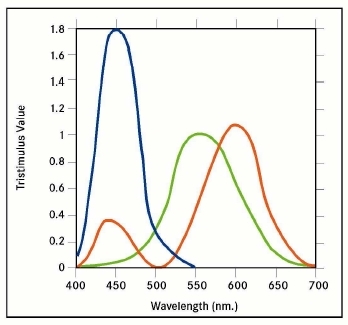 |
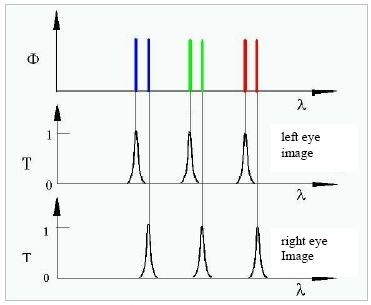 |
| Sensitivity of the color receptors of the human eye. Source: Infitec. |
Transmission of two types of narrow band filters. Each can reproduce full color pictures. Source: Infitec. |
|---|
A spinning filter wheel intercepts the light from the lamp before it reaches the DLP chips. The wheel has two interference filters, passing primary colors as shown in the figure. This wheel is synchronized with the movie frames, so that movie content intended for the left eye has come through one filter, and light intended for the right eye has come through the other filter. No other filtration in the projection booth is required. The passive glasses worn by the audience have interference filters that ensure that each eye sees only its appropriate image.
The filters transmit narrows band of red, green, and blue for the left eye, and slightly different bands of red, green, and blue for the right eye. A discerning eye might notice a very slight difference in color between the two images, but the brain doesn't care, easily integrating the two into natural color. This is another example of technology exploiting a subtle fact of sensory psychology.
The filters of the color wheel, and the glasses, are multi-layer (50 layer) dielectric filters. The glasses have curved, not flat, surfaces, and are scratch resistant for longer useful life.
Tilting of the head causes no problems. The color filtration is entirely at the light source, so it doesn't compromise image quality. But the narrow band transmission filters lose 70% of the lamp's light at the source. All of the 3-d systems are very wasteful of light, with only a small fraction of the light reaching the eyes of the audience. Single projector 3-d systems allow only 12% to 38% of the lamp's light to reach the eye, depending on the method used. No solution to this problem is seen on the horizon.
The Grand Illusion.
Many innovations of science and technology have converged to make 3-d cinema practical. The movies have been called a "grand illusion". A succession of static photographs gives the illusion of continuous motion. A few selected colors are combined to recreate a full spectrum of color. Two sets of still pictures combine to give the illusion of depth and solidity. Light itself has been realigned and twisted and its spectrum manipulated. Multiple loudspeakers give the illusion of sound that can surround you. Computer graphics simulate reality and even make unreality seem real. All of these use subtle tricks of psychology to fool the eye and ear, and all combine to create a unified illusion of a real, or fantasy world. Early filmmakers creatively overcame limitations of the medium. Today's filmmakers have far fewer technical limitations, and now have a medium that is capable of recreating anything they can imagine. We hope their intelligence and artistic judgment is equal to the task.
For more information:
HyperPhysics web site, http://hyperphysics.phy-astr.gsu.edu/hbase/hframe.html, more about polarized light.
Texas Instruments: http://www.dlp.com/ , the DLP chip.
Imax 3-d: http://www.imax.com/ImaxWeb/welcome.do.
Real-D: http://www.reald-corporate.com/aboutus.asp.
Infitec: http://www.infitec.net/infi_e.html.
Dolby 3-d: http://www.dolby.com/professional/motion_picture/solutions_d3ddc.html.
Rob Crockett's web site http://www.ledametrix.com/index.html has a great collection of stereo pictures taken by various methods and viewable by either the parallel or cross-eyed method.
For a nice collection of over a thousand stereo view cards, see The World of Sereo Views: http://www.worldofstereoviews.com/.

